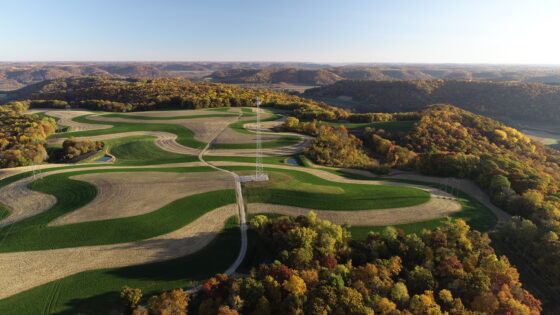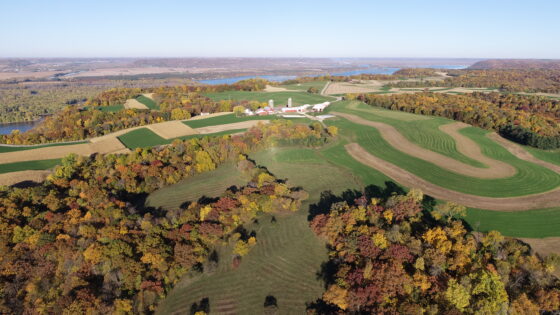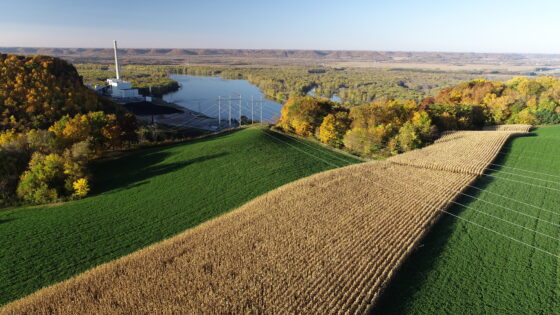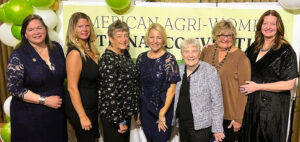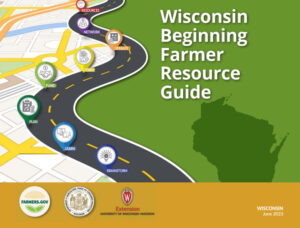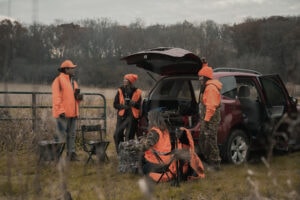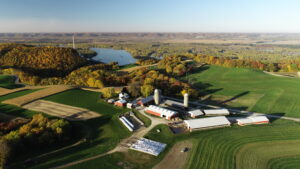Brattlie The Rabbit Supreme Exhibitor
Hanna Brattlie of Cambridge is the 2023 Wisconsin State Fair Rabbit Supreme Exhibitor. The Supreme Exhibitor award is based on a junior exhibitor’s overall achievements at the 2023 Fair from points earned participating in the Junior Rabbit show, Quiz contest, Communication contest and Showmanship.
Brattlie has exhibited at Wisconsin State Fair for the past four years but started out as an open exhibitor in 2019. In 2022, she began showing in the Rabbit Junior show. She also participated in the communications, quiz and showmanship contests for the first time. In addition to showing rabbits, she also started exhibiting poultry at Wisconsin State Fair in 2022.
Brattlie currently attends UW-Platteville as a college freshman where she is pursuing a degree in Animal Science. Hanna stated that this year was special to her because she was assigned a random roommate by her university. She later found out that she would also be exhibiting at Wisconsin State Fair. They met for the first time during the Junior Poultry show.
Wisconsinite Elected To American Agri-Women
Pictured: (left to right) Rose Tyron, Chrissy Hebbourn Wozniak, Jean Goslin, Heather Hampton Knodle, Arlene Kovash, Kathy Goodyke, Kim Bremmer. Image courtesy of American Agri-Women.
American Agri-Women recently elected its national officers at its 2023 national convention in Sacramento. Kim Bremmer of Loyal and affiliated with Wisconsin Agri-Women was elected First Vice President.
AAW is a national coalition of farm, ranch, and agri-business women. The group is in its 49th year of advocating for agriculture.
Other officers on the team:
President – Rose Tryon, California
Vice President of Communications – Chrissy Wozniak, Florida
Treasurer – Kathy Goodyke, Minnesota
Past President – Heather Hampton Knodle, Illinois
Secretary – Arlene Kovash, Oregon
Vice President of Education – Jean Goslin, Kansas
Wisconsin Farms Receive Rural Energy Grants
Senator Tammy Baldwin announced she helped deliver nearly $6 million in grants from the U.S. Department of Agriculture (USDA) for more than 50 Wisconsin farmers, ranchers, and businesses to invest in renewable energy, upgrade to energy efficient equipment, and cut their energy costs. The grants, from the Rural Energy for America Program (REAP), help agricultural producers as well as rural small business owners make energy efficiency improvements and renewable energy investments to lower energy costs, generate new income, and strengthen the resiliency of their operations.
“Investing in renewable energy for Wisconsin is a win-win for our farmers, businesses, and environment. By installing more energy efficient equipment and renewable energy like solar panels, Wisconsinites can see their energy bills go down, helping them re-invest more dollars back into their businesses and workers,” said Senator Baldwin. “I am proud to support these investments which pay for themselves, saving Wisconsinites money and combatting the impacts of climate change like extreme weather, flooding, and drought.”
The REAP program received a $2 billion boost through the Baldwin-backed Inflation Reduction Act. REAP is helping farms and also small businesses invest in renewable energy and energy efficiency improvements. These investments will lower their energy costs, generate new income, as well as strengthening the resilience of their operations. Over 50 farms and businesses in Wisconsin were awarded REAP grants earlier this month, including:
Kinnard Farms in Casco – $403,507 to help Kinnard Farms Inc., a dairy farming operation, install a new feed handling system. This project will save $163,059 per year. It will replace 1,186,313 kilowatt hours (kWh) (45 percent of the company’s energy use) per year. This is enough energy to power 109 homes.
Lemere Farms in Oconto – $92,404.00 to help LeMere Farms LLC, a farming operation, install a grain drying system. This project will save $11,664 per year. It will replace 164,830 kilowatt hours (kWh) (90 percent of the company s energy use) per year. This is enough energy to power 15 homes.
I-K-I Manufacturing in Edgerton – $371,700 to install a 497 kilowatt (kW) roof mounted solar array. I-K-I Manufacturing Co. Inc. is an aerosol can manufacturing company. This project will save $74,474 per year. It will replace 600,600 kilowatt hours (kWh) (73 percent of the company’s energy use) per year. This is enough energy to power 55 homes.
Nidus Hospitality in Wausau – $157,500 to help Nidus Hospitality LLC, a hotel operation, make energy efficiency improvements to the hotel’s elevator system. This project will save $55,675 year. It will replace 482,038 kilowatt hours (kWh) (82 percent of the energy used by the elevator system) per year. This is enough energy to power 44 homes.
Tomahawk Terminal Company in Tomahawk – $106,183 to help Tomahawk Terminals Company install a small solar electric array. The project will save $5,998 per year. It will replace 103,225 kilowatt hours (kW) (100 percent of the business’s energy use) per year. This is enough energy to power nine homes.
Tom Saffert & Sons in Rice Lake – $145,440 to install a more energy efficient grain dryer. Tom Saffert & Sons SCG is a farming operation. This project will save $7,422 per year. It will save 103,561 kilowatt-hours (kWh) (63 percent of the farm’s energy use) per year. This is enough energy to power nine homes.
CVG in Eau Claire – $58,400.00 to help CVG LLC install a small solar electric array. The project at this farming operation will save $6,364 per year. It will replace 62,041 kilowatt-hours (kWh) (87 percent of the farm’s energy use) per year. This is enough energy to power five homes.
COMWAS in Ettrick – $100,160.00 to install a small solar electric array. COMWAS Inc. is a rural small business. This project will save $19,990 per year. It will replace 177,802 kilowatt-hours (kWh) (100 percent of the business’s energy use) per year. This is enough energy to power 16 homes.
Coming Full Circle In Farmland Care
Farmers know that they must care for the land if they want the land to support agriculture. What proper farmland care consists of differs from farm to farm. The one thing they all share is a desire to be sustainable – ensuring that the land can stay productive for themselves and also future generations. Full Circle Farm in Seymour is a farm centered on sustainability. They are a finalist for the 2023 Leopold Conservation Award.
The Leopold Conservation Award is a competitive award that recognizes landowner achievement in voluntary conservation. Given in honor of renowned conservationist Aldo Leopold, the prestigious award recognizes farmers and forestland owners who inspire others with their dedication to land, water, and wildlife habitat in their care. Full Circle Farm is one of the four finalists.
Full Circle Farm is very intentional in how they care for the land that has been in the family since 1890. The farms longevity is a prime example of sustainability to Valerie Dantoin whose husband, Rick, inherited the farm. Dantoin states, “To me, that’s what a sustainable farm really means…if something lasts for 130 years, that’s really pretty good.”
The farm, as most across the state, began as a homestead. The farm was on 80 acres where the family raised pork and had a large garden. In the 1940’s, the family transitioned away from pork and into dairy. When Valerie and Rick took over the farm, they built a milking parlor, milked 200 cows, and transitioned into the organic market.
“That was really really beneficial for the farm to stay sustainable as well,” said Dantoin. “Now our next generation on the farm is doing organic vegetables.” They created a Community Supported Agriculture and are direct marketing their vegetables. The farm raises beef and pigs for meat and chickens also provide eggs. Full Circle Farm has grown substantially over the years. During the summer, there are usually 8 fulltime employees to help with the vegetables.
One of the most important conservation practices used by the farm is managed grazing. “What that does is it keeps a living cover, a green blanket, on the soil at all times,” Dantoin says. “Hundred percent of the year. There’s a living root in the soil, so we’re sequestering carbon that way.”
The motivation for utilizing practices like managed is simple. “It’s just built into the DNA,” Dantoin says simply. “The name of the farm, Full Circle, means we went and looked back at some of the best practices that previous generations used.”
Effectively Representing Agriculture To A Broad Audience
Wisconsin Farm Bureau is offering a new advocacy initiative for its members. Applications for Wisconsin Farm Bureau’s inaugural WisGO Team are now open.
WisGO Team members are advocates and thought leaders on issues impacting agriculture. These members will serve as influential and authoritative individuals to be called upon for media interviews, legislative testimony and social media advocacy.
The WisGO Team is Wisconsin Farm Bureau’s first line of contact when speaking on agricultural issues. Members of the WisGO Team will develop a skillset to effectively interact with media representatives as well as educate and influence others on prominent issues impacting agriculture. Members will learn effective strategies to share their stories to a broad audience through multiple media platforms.
Voting members of Wisconsin Farm Bureau with a willingness to step forward and be involved with lawmakers, media and consumers are eligible and encouraged to apply.
Fifteen individuals will be selected to serve on this year’s WisGO Team. Selected individuals will participate in four educational sessions throughout the year:
- February – Media training at the WFBF Office in Madison
- April – Virtual issues update
- July – Policy development review and issue updates at the WFBF Office in Madison
- October – Virtual issues update
WisGO Team members serve as official spokespersons for Farm Bureau and agriculture issues. Throughout the program, participants will gain a deeper understanding of agricultural issues, expand their network with fellow farmers and agriculturists across the state and be a voice for Wisconsin agriculture.
Applications are now open and will close on Friday, December 8. Please visit bit.ly/WisGOteam to apply.
New Farmers “Road Map” To Success
Being a new farmer trying to start out can be scary. From the investment, market volatility, land prices, and even trying to live up to what others are doing. There are many organizations working hard to provide support and resources to help new and younger farmers succeed. However, for a young farmer, figuring out where to begin can be stressful. With limited time and resources, the question becomes: Who do I talk to first? To address this issue, the Department of Agriculture, Trade, and Consumer Protection (DATCP) partnered with the Farm Service Agency (FSA) to create a valuable resource – the Wisconsin Beginning Farmer Resource Guide.
“This resource guide is a blueprint for aspiring farmers, offering a step-by-step approach to building a new farm or agribusiness,” explains Dan Bauer, Program Supervisor at the Wisconsin Farm Center. “It breaks down the journey into several key phases and also has a dedicated section to networking to help connect these new farmers with those already in the industry.”
The guide covers the following topics:
- Brainstorming: Start by identifying your business idea. What kind of farm or agribusiness are you passionate about?
- Learning: Dive deep into understanding your chosen field. Education is crucial in any industry, and farming is no exception.
- Planning: Develop a business plan. A solid plan is the foundation for success in farming.
- Funding: Access to capital is essential. Whether it’s for equipment purchases, marketing, or other expenses, you’ll need financial support.
- Forming: This phase involves getting your legal and also administrative affairs in order. You must establish your business as a recognized entity to reap the benefits.
- Operating: Once you have your idea, education, plan, and funding in place, you can officially start operating your business.
When it comes to financial support for young farmers, it’s important to consider the available grants, loans, and assistance programs. The FSA offers specific programs for beginning farmers, including direct and guaranteed loan programs with lower interest rates. They also have a microloan program designed to help farmers during their startup years. In addition to FSA programs, the USDA is another valuable resource for grant opportunities and financial support.
“I know navigating these loans can be tough,” says Bauer. “If you’re having trouble knowing how to begin, reach out to the Farm Center and we can help provide guidance, review business plans, and offer valuable insights from years of experience working with farmers.”
Beef Cutout Value Is Showing Strength
The following report was prepared and written by Jeff Swenson, DATCP’s livestock and meat specialist the week of 11/3. This report draws information from several sources, including trade publications, radio broadcasts, agricultural news services, individuals involved in the industry as well as USDA reports.
Cattle
Last week brought a high level of volatility to the market. Cash fed cattle were lower, although negotiated trade in the South was steady by week’s end. Some traders are questioning the accuracy of the recent Cattle on Feed report, but no one can cast doubt on the impact it had on the cattle complex. Feeder cattle prices at auction markets across the country were mostly lower. All indications tell us many beef heifers are being marketed as feeders and feds. There are reports that herd rebuilding is taking place in some regions, but it is limited.
Cash cattle were $2.40 lower with the National Daily Cattle and Beef Summary publishing a weighted average beef breed steer price of $183.53. Even at this lower level, fed steer prices are $32.00/cwt higher than a year ago. The Choice beef cutout value is showing strength, up $1.85 to average $306.49. The weekly harvest estimate of 636,000 head was 2,000 lower than the previous week and 31,000 head below the same week last year. The USDA released a Cold Storage report last week showing that beef in freezers on September 30 were 6% higher than August, but 20% below September of last year.
Cattle Prices
Fed cattle prices were steady with last week. High Choice and Prime beef breed steers and heifers brought $173 to $178/cwt with highs of $185/cwt. Choice steers and heifers ranged from $166 to $173/cwt. with mixed grading and those likely to grade Select bringing $155 to $166/cwt. Holstein steers were mostly steady, bringing $150 to $158/cwt with some lots from $158 to $162. Lower grading steers brought $125 to $150. Silage fed, under finished, or heavy dairy breed steers brought $75 to $125/cwt. Dairy x Beef steers were bringing $126 to $173 with a few to 180/cwt.
Cows were $2 lower. A bulk of the cows brought $67 to $95/cwt, with some fleshier dairy and beef cows selling to $105/cwt, with reports of individuals selling higher. Doubtful health and thin cows were bringing $67/cwt and down. Dairy breed bull calves were steady, bringing $100 to $300/cwt with some heavier, well-managed calves selling to $420.
Beef and Beef Cross calves were lower, selling up to $700/cwt.
Hogs
Lean hog futures contracts recovered more quickly than the cattle complex last week. The December Lean Hog contract ended the week $4.40 higher. Cash hog prices were called $1.50 lower, however. Packers did bid higher to open this week. The pork cutout value was lower, averaging $87.37.
Last week’s estimated hog harvest was 2.614 million, up 4,000 on the week and 50,000 head higher than a year ago. Even with larger weekly harvest totals, pork production has leveled off and is comparable to a year ago due to lower hog weights. Ample supply of market hogs will continue into 2024.
Pork in cold storage is 14% below a year ago, and down 1% from the end of August. All primals in storage were lower except for loins. Net pork export sales for October 13-19, 2023 were down 8% from the previous week and from the prior four-week average. Mexico (10,200 metric tons) and China (3,400 metric tons) were the leading buyers.
Lamb
Cash fed lambs were mixed last week. The USDA National Sheep Summary called traditional lambs $10 to $15 lower, with light lambs steady to $20 higher. Ewes were steady to $5 lower with feeder lambs showing good demand and called $7.00/cwt higher.
Harvest continues to outpace last year with last week’s estimate at 37,000 head. That is 1,000 more than the previous week and 3,000 more than a year ago.
The lamb cutout jumped $8.49 last week to finish at $471.57. Holiday demand will be key in maintaining American lamb prices through the end of the year.
Lamb and mutton in cold storage at the end of September was 15% lower than a year ago.
Market lambs were lower from $160 to $190/cwt.
Wisconsin Brings Home 2 More National Winners
Ethan Lulich of the Mauston FFA Chapter is the 2023 National FFA Agricultural Proficiency Award winner in the Landscape Management – Entrepreneurship/Placement category.
Lulich works for his father’s landscaping business, which includes a retail garden center, landscaping installation crew, and a lawn care maintenance crew. He helps design outdoor living spaces including patios, firepits, sitting walls, walkways, stairs, lighting, irrigation systems, and water features. Lulich is supported by his parents, Lori and David, and his FFA advisor, Beth Babcock.
Cody Hudziak of the Weuaywega-Fremont Chapter also came home a winner. Hudziak is is the 2023 National FFA Agricultural Proficiency Award winner in the Vegetable Production – Entrepreneurship/Placement category.
He has two placements for his supervised agricultural experience (SAE): one at the aquaponics system in his agriculture classroom and the other at Del Monte Foods. He was manager of the aquaponics system, growing buttercrunch lettuce in the system that is grown in water with fish waste. At Del Monte, he worked to grow green beans, potatoes, carrots and beets. Hudziak is supported by his parents, Kimberly and Duane, and his FFA advisors Sandra Dykes, Connie Peterson and Jessica Magdanz.
Your Deer Could Stock A Food Pantry
The Wisconsin DNR encourages hunters to donate Wisconsin-harvested deer through the DNR’s Deer Donation Program. The program helps stock food pantries for the upcoming holiday season and supports residents in need throughout the state.
The program started in 2000. Since then, hunters have donated 98,000 deer, totaling over 3.9 million pounds of venison, to help Wisconsinites in need.
Wisconsin has a network of venison donation partners. This includes county land and water conservation departments, food pantries, charitable organizations, USDA – Wildlife Services and participating meat processors. They all help implement and administer the program.
“This is a great opportunity for hunters to showcase their sportsmanship and help individuals in their local communities facing food insecurity,” says DNR program administrator Grace Nugent.
According to data from the Department of Health Services, more than 900,000 Wisconsin residents received food assistance in 2022.
“There is a big demand for venison provided through the Deer Donation Program, and we are hopeful hunters will continue to donate their deer and help those in need,” she says.
Hunters interested in donating a Wisconsin-harvested deer to the DNR’s Deer Donation Program should follow these steps:
- Field dress the deer.
- Register the deer through GameReg: https://gowild.wi.gov/wildlife/harvest Please note the registration confirmation number and keep it on hand when dropping off the deer.
- Test the deer for CWD before taking the deer to a processor if harvested from a CWD-affected county. A list of CWD sampling locations is available on the DNR’s Sampling For Chronic Wasting Disease webpage: https://dnr.wisconsin.gov/topic/WildlifeHabitat/registersample
- Call ahead. Contact a participating processor before dropping off the deer to make sure they have space to accept it. Some processors might join later in the season, so check back if you don’t see one currently in your area: https://widnr.widen.net/s/mfx7dpjzzq/processor_deer_donation_list
- Bring the deer to the processor. If donating a deer being tested for CWD, inform the processor and provide the CWD barcode number. The processor will not distribute the deer until the results are known.
Meet Another Leopold Finalist – Noll’s Dairy Farm
Images courtesy of Mark Noll.
Mark Noll describes his farm in the Driftless Region as a slice of heaven. But it didn’t get to be that way overnight. Noll’s Dairy Farm in Buffalo County has worked the land for generations to make sure that the soil stays in place, the oak trees grow tall, and the wildlife have a place to call home.
The farm is one of four finalists selected for the 2023 Wisconsin Leopold Conservation Award. Given in honor of renowned conservationist Aldo Leopold, the prestigious award recognizes farmers and forestland owners who inspire others with their dedication to land, water, and wildlife habitat in their care.
The Noll family in Alma has practiced soil and water conservation efforts on their farm for generations. The land sits on top of a 500-foot bluff overlooking the Mississippi River. Mark tells Mid-West Farm Report he can watch the barges go down the river from his tractor seat. Curtis, Mark, and Scott Noll grow cover crops and utilize no-till and contour strip cropping practices to prevent soil erosion.
They also restored and actively manage an ecologically rare dry bluff prairie that is home to many endangered species. Their managed forest provides oak timber production and wildlife habitat.
“I want to leave the land better than when I started. The land is going to be here forever. We’re just here for an eye-blink really,” Mark says. “It’s tough to do sometimes but… when I’m out in the corn planter, there’s no where else I’d rather be.”
In Wisconsin, the $10,000 award is presented annually by Sand County Foundation, American Farmland Trust, Wisconsin Farm Bureau Federation and Dairy Farmers of Wisconsin. But when asked how it felt to be recognized by his community and nominated as a finalist for the conservation prize, Mark says: “We just did it because we thought it was the right thing.”
This year’s recipient will be revealed at November’s meeting of the Board of Agriculture, Trade and Consumer Protection. Earlier this year, owners of Wisconsin farmland and forests were encouraged to apply (or be nominated) for the award. Applications were reviewed by an independent panel of agricultural and conservation leaders.
The other three finalists are:
- Bartling’s Manitowish Cranberry Co. of Manitowish Waters in Vilas County: https://www.midwestfarmreport.com/2023/10/27/a-berry-good-harvest/
- Full Circle Farm of Seymour in Shawano County: story coming soon
- Joe Hovel of Conover in Vilas County: story coming soon
The first Wisconsin Leopold Conservation Award was presented to woodland conservationist Gerry Mich of Appleton in 2006. The 2022 recipients were Joe and Christy Tomandl of Medford.
